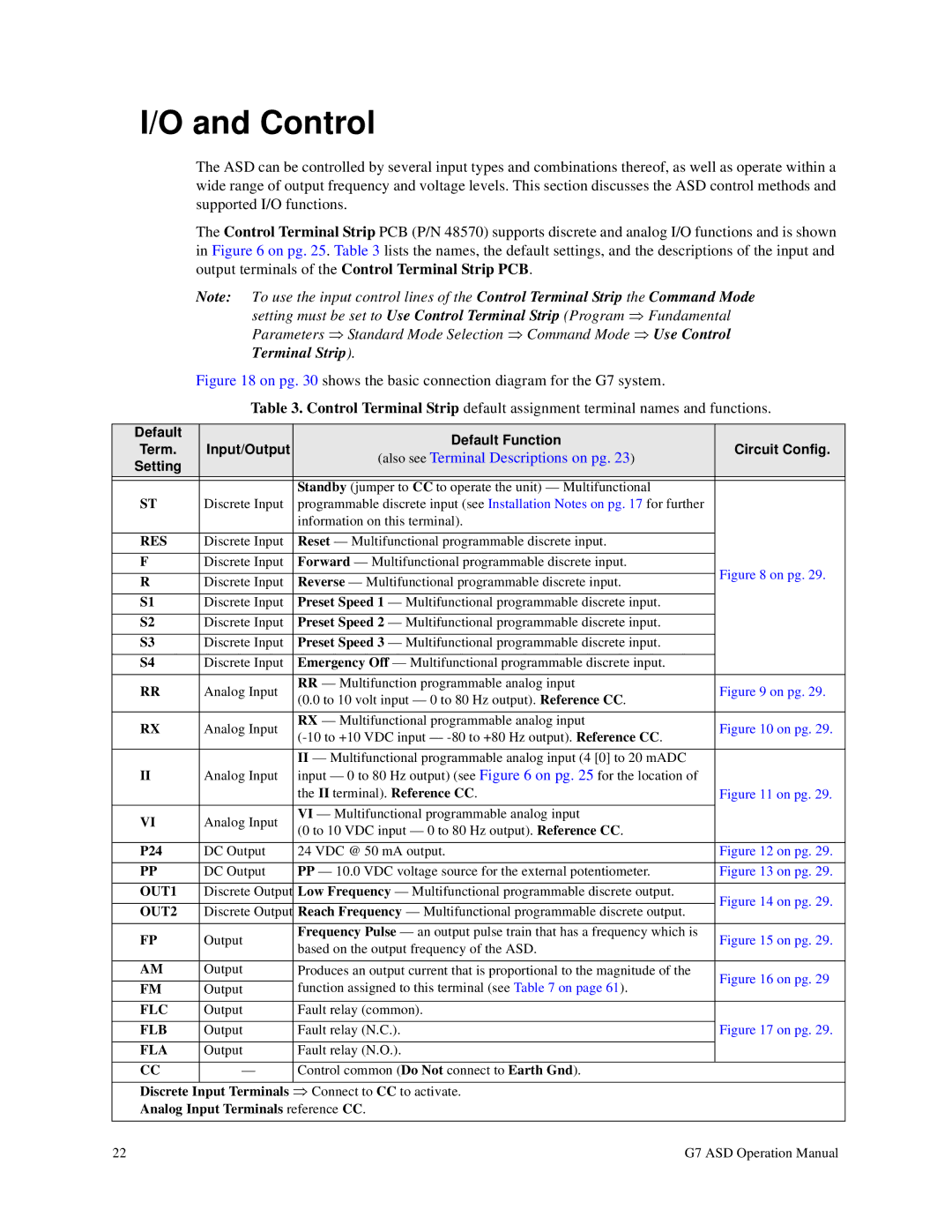
I/O and Control
The ASD can be controlled by several input types and combinations thereof, as well as operate within a wide range of output frequency and voltage levels. This section discusses the ASD control methods and supported I/O functions.
The Control Terminal Strip PCB (P/N 48570) supports discrete and analog I/O functions and is shown in Figure 6 on pg. 25. Table 3 lists the names, the default settings, and the descriptions of the input and output terminals of the Control Terminal Strip PCB.
Note: To use the input control lines of the Control Terminal Strip the Command Mode setting must be set to Use Control Terminal Strip (Program ⇒ Fundamental Parameters ⇒ Standard Mode Selection ⇒ Command Mode ⇒ Use Control Terminal Strip).
Figure 18 on pg. 30 shows the basic connection diagram for the G7 system.
Table 3. Control Terminal Strip default assignment terminal names and functions.
Default |
| Default Function |
| |
Term. | Input/Output | Circuit Config. | ||
(also see Terminal Descriptions on pg. 23) | ||||
Setting |
|
| ||
|
|
| ||
|
|
|
| |
|
| Standby (jumper to CC to operate the unit) — Multifunctional |
| |
ST | Discrete Input | programmable discrete input (see Installation Notes on pg. 17 for further |
| |
|
| information on this terminal). |
| |
|
|
|
| |
RES | Discrete Input | Reset — Multifunctional programmable discrete input. |
| |
|
|
|
| |
F | Discrete Input | Forward — Multifunctional programmable discrete input. | Figure 8 on pg. 29. | |
|
|
| ||
R | Discrete Input | Reverse — Multifunctional programmable discrete input. | ||
| ||||
|
|
|
| |
S1 | Discrete Input | Preset Speed 1 — Multifunctional programmable discrete input. |
| |
|
|
|
| |
S2 | Discrete Input | Preset Speed 2 — Multifunctional programmable discrete input. |
| |
|
|
|
| |
S3 | Discrete Input | Preset Speed 3 — Multifunctional programmable discrete input. |
| |
|
|
|
| |
S4 | Discrete Input | Emergency Off — Multifunctional programmable discrete input. |
| |
|
|
|
| |
RR | Analog Input | RR — Multifunction programmable analog input | Figure 9 on pg. 29. | |
(0.0 to 10 volt input — 0 to 80 Hz output). Reference CC. | ||||
|
|
| ||
|
|
|
| |
RX | Analog Input | RX — Multifunctional programmable analog input | Figure 10 on pg. 29. | |
|
|
| ||
|
|
|
| |
|
| II — Multifunctional programmable analog input (4 [0] to 20 mADC |
| |
II | Analog Input | input — 0 to 80 Hz output) (see Figure 6 on pg. 25 for the location of |
| |
|
| the II terminal). Reference CC. | Figure 11 on pg. 29. | |
|
|
|
| |
VI | Analog Input | VI — Multifunctional programmable analog input |
| |
(0 to 10 VDC input — 0 to 80 Hz output). Reference CC. |
| |||
|
|
| ||
|
|
|
| |
P24 | DC Output | 24 VDC @ 50 mA output. | Figure 12 on pg. 29. | |
|
|
|
| |
PP | DC Output | PP — 10.0 VDC voltage source for the external potentiometer. | Figure 13 on pg. 29. | |
|
|
| ||
OUT1 | Discrete Output Low Frequency — Multifunctional programmable discrete output. | Figure 14 on pg. 29. | ||
|
|
| ||
OUT2 | Discrete Output Reach Frequency — Multifunctional programmable discrete output. | |||
| ||||
|
|
|
| |
FP | Output | Frequency Pulse — an output pulse train that has a frequency which is | Figure 15 on pg. 29. | |
based on the output frequency of the ASD. | ||||
|
|
| ||
|
|
|
| |
AM | Output | Produces an output current that is proportional to the magnitude of the | Figure 16 on pg. 29 | |
|
| function assigned to this terminal (see Table 7 on page 61). | ||
FM | Output | |||
| ||||
|
|
|
| |
FLC | Output | Fault relay (common). |
| |
|
|
|
| |
FLB | Output | Fault relay (N.C.). | Figure 17 on pg. 29. | |
|
|
|
| |
FLA | Output | Fault relay (N.O.). |
| |
|
|
|
| |
CC | — | Control common (Do Not connect to Earth Gnd). |
| |
Discrete Input Terminals ⇒ Connect to CC to activate.
Analog Input Terminals reference CC.
22 | G7 ASD Operation Manual |
